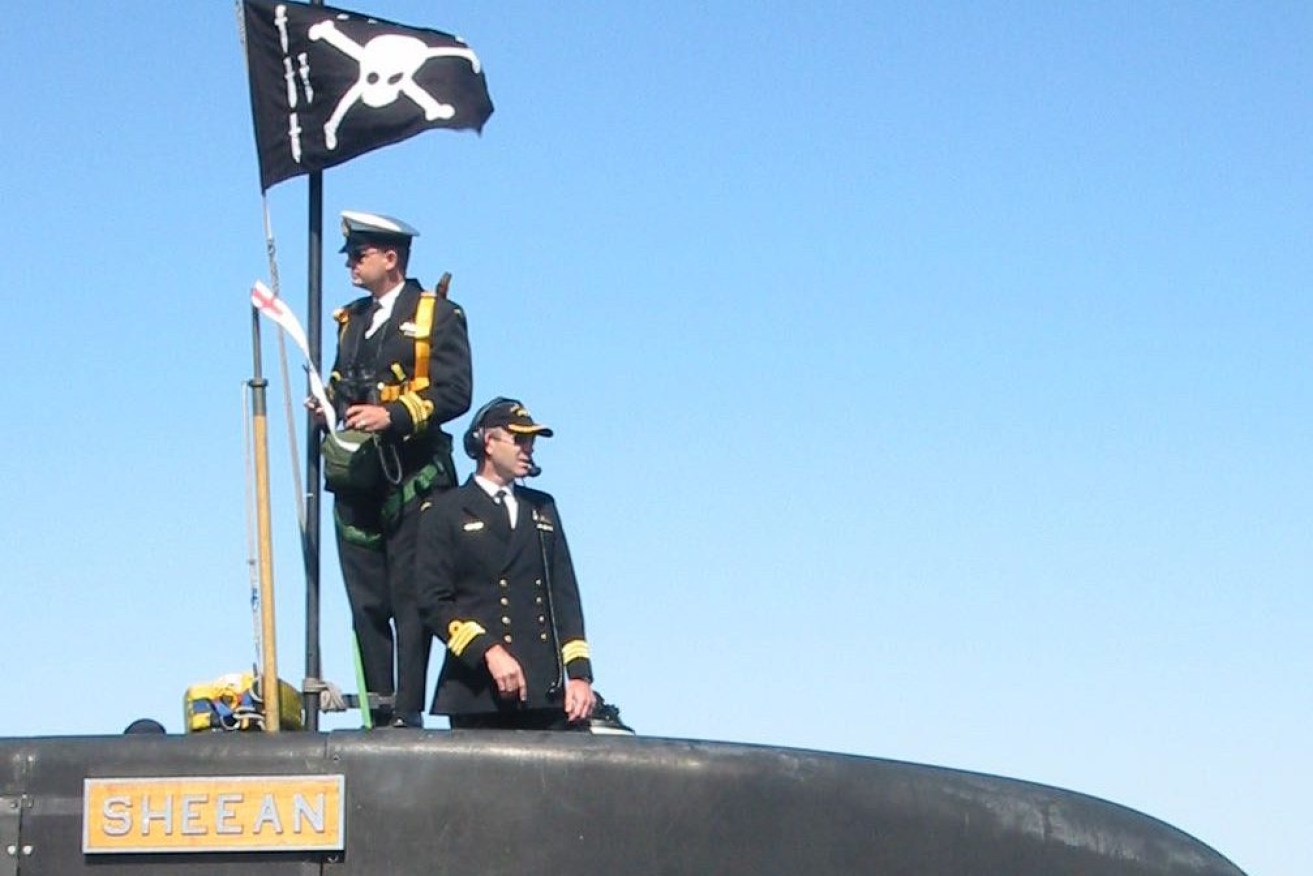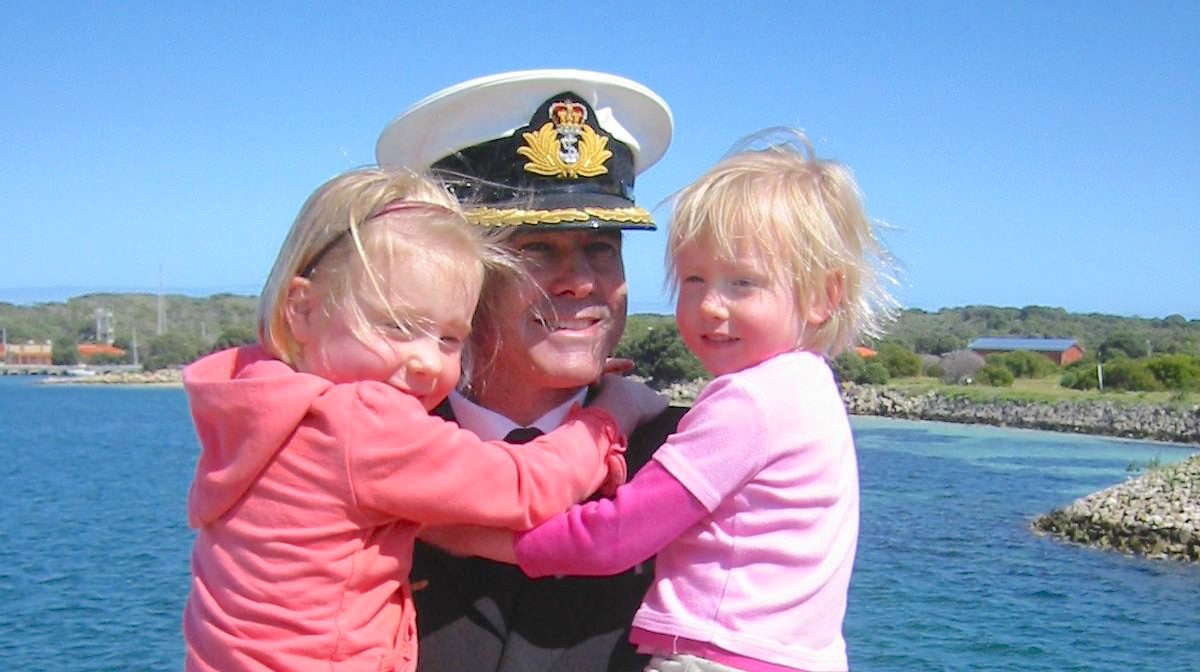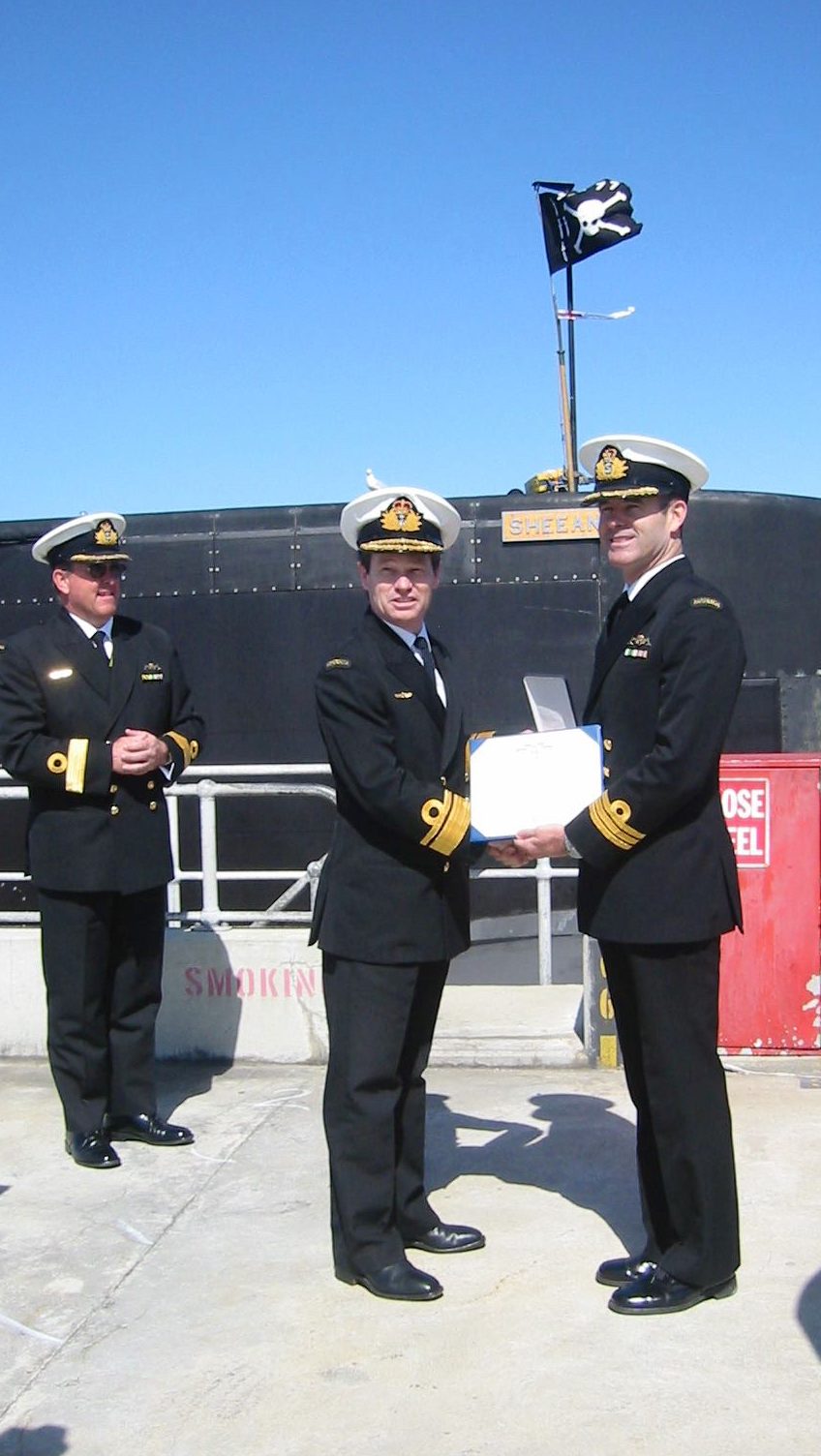Sub commander’s secret missions under the seas
Andy Keough worked on top secret missions commanding Collins Class submarines in the murky depths of the world’s oceans. When the Last Post bugle call sounds on Anzac Day, those memories will visit his quiet contemplation.


Former HMAS Sheean submarine commander Andy Keough (right). The skull and crossbones flag is flown on return from operations. Photo: supplied
It’s been 17 years since Keough commanded the nation’s HMAS Waller and HMAS Sheean submarines, but it still feels like the distinguished naval veteran is firmly in control of his surroundings as he sips a macchiato at a Hutt Street café.
There is an unassuming self-assurance about the now managing director of defence company Saab Australia as he chats about more than two decades serving in the Royal Australian Navy and the cloak and dagger world of submarine intelligence gathering.
A career recognised with the esteemed Conspicuous Service Cross for leadership and one that makes Keough one of the nation’s few to wear the distinctive dolphins badge worn by Australian submariners to have been to sea on nuclear-powered vessels with the United States Navy.
Keough started his submarine service on Australia’s Oberon-class boats. He describes a feeling of luxury in taking command of the Collins sub HMAS Waller in 1999, a wry smile as he tells of fresh white walls, reduced bunk-bed sharing and ducking of heads under doorways.
The Oberons were only about 2,500 tonnes with a crew of 60, while the new diesel-powered Collins were about 3,500 tonnes with a smaller crew of 50 to 55.
“(The Oberons) were extremely small; probably the best analogy is like being on a caravan, except you are inside that caravan for three to four weeks at a time and the caravan doesn’t have too many windows,” Keough says with a laugh.
One of the best spots to sleep was “up among the torpedoes” where there was more space and quiet.
“Some people would find it extremely claustrophobic and others would find it normal,” he says of working in the confined space deep under water, but “the space becomes secondary to you as you are actually working and you are focusing on the task at hand.”
There is a warmth as Keough talks about his time on submarines.
He refers to the strength of teamwork, and remembers once taking a national defence reporter aboard when a deluge of “dud subs” stories plaguing the new Collins Class submarines began affecting crew morale.
Telling stories about the Collins subs’ strengths is always a tough ask when the very nature of submarine service is to keep missions secret.
Submarines are all about stealth, Keough says. They cruise silently beneath the water far away from the Australian coastline to observe “what nations in our region are doing and form an understanding about what are the threats that Australia faces”.
“A submarine is sometimes analogised to a vacuum cleaner – it hoovers up any signals, noise around it, and is able to record that, both noises under water and any electronic, magnetic signature above the water,” Keough says.
It can then determine where signals originate and how that platform (a ship for example) is being operated so Australia can make assessments about the capability of regional navies.
This stealth and secrecy can also take its toll on the crew when they are deployed for more than six months at a time, far away from family members who are left in the dark about where their loved ones are travelling.
Keough remembers it was only a month after he arrived home from a six-month deployment that his first daughter, Emily, now 22, was born. His seafaring commitments meant he was also away from his wife, Meg, and second daughter Hannah, now 20, for long periods.

Andy Keough with his daughters after a six-month deployment in 2005. Photo: supplied
It also meant there were several moves. The family shifted to Hawaii in 2001 and Keough was a commander on exchange with the United States Pacific submarine fleet until 2004. At the time he was one of Australia’s few submariners to have gone to sea onboard a nuclear-powered vessel.
A unique experience, as the nation now works toward replacing its current diesel-operated Collins with nuclear-powered submarines from the United States and to build its own with support from the United Kingdom.
The $368 billion AUKUS program announced last month comes at an important time, according to Keough, as war in the Ukraine shows no sign of ending and “potential flashpoints” in the South China Sea or around Taiwan continue to simmer.
“I know many people I speak to in Sweden (where Saab’s head office is based) were shocked that they would have seen a war in Europe in their lifetime,” Keough says.
“It’s hard to understand but I often remind people that the distance from Stockholm (the capital of Sweden) to Kyiv (in the Ukraine) is similar to the distance from Adelaide to Sydney.”
There are more connections between Keough and the acquisition of new submarines.
The former subs commander worked at ASC on the upkeep of the Collins and then later was chief executive at Defence SA supporting Japanese, French and German bidders on the now scrapped Attack class plan to replace the Collins with diesel-powered vessels.

Andy Keough (right) after returning from a six-month deployment on HMAS Sheean in late 2005. Fleet Commander Rear Admiral Davyd Thomas presents an award, the submarine/crew were awarded the Gloucester Cup for demonstrating the “highest level of proficiency” ie the best ship of the entire navy for that year. Photo: supplied
Now, Keough heads Saab Australia at its Adelaide headquarters. The global submarine designer and builder took over Kockums, the original builders of the Collins Class submarine, in 2014.
The company works on the Collins Life of Type extension programme, but Keough believes the new nuclear-powered plan is the right way forward for Australia’s unique circumstances around long-range capability.
“It’s exciting that we (Australia) have taken the step to operate nuclear submarines,” he says, adding that they will provide greater capability and that he is comfortable with the nuclear reactor aspect of the project.
“Having insight into the US navy management of nuclear power, there’s no area that has higher regulatory oversight.”
On Anzac Day, Keough will not only reflect on this long submarine career that has led to an Australian Service Medal, a Long Service Medal, a Defence Service Medal and the Conspicuous Service Cross – but also the long history of others who have chosen the same commitment.
He will remember friends who have died in operations and others across navy, air force and army dealing with PTSD after service.
And, as Australians think about those that have chosen to protect their country on the anniversary of Australian and New Zealand soldiers landing at Gallipoli peninsula, Keough hopes there will be time set aside for the submariners in our defence history.
“A lot of the imagery from my early days was of the Anzacs arriving on the beach at the Gallipoli peninsula, but of course these days we quite rightly have a much wider appreciation of all campaigns,” he says of the day of remembrance.
“Even there, in the Gallipoli campaign, the very morning that the troops were going ashore on the Gallipoli peninsula – on the eastern side of that very peninsula an Australian submarine was manoeuvring its way through a minefield.”
The AE2 and its crew was the first submarine to breach the narrow Straits of the Dardanelles to disturb Turkish supply lines on April 25. It was later sunk on April 30, 1915, and its crew captured by Turkish forces. Four of the crew died in captivity.
Information on SA Anzac Day services can be found at RSL South Australia. A list of regional SA services can also be found here.




